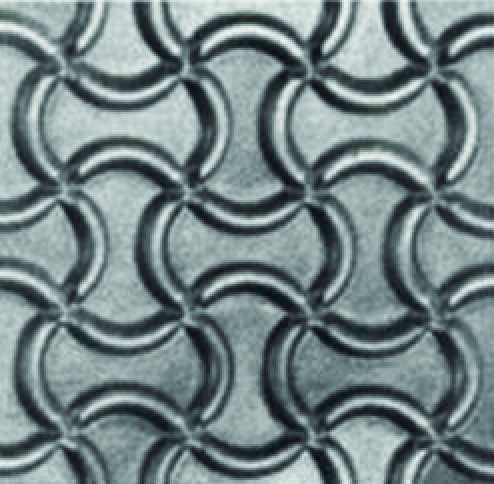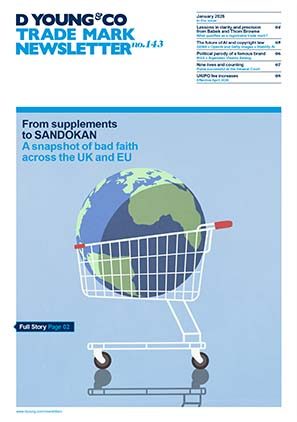Registrability: seeing a distinct pattern?
Patterns are difficult to obtain registered protection for as they are typically considered to lend an aesthetic appeal to goods. The pattern mark is a ‘new’ creature at the EUIPO, as it only became possible to categorise applications in this manner from 01 October 2017 onwards. Whilst the concept did exist before then, pattern marks were covered under the broader category of “figurative” marks.
There are currently 25 pattern marks lodged on the EUIPO database (not limited by status pending/registered/refused etc.), and 10 of them are registered. This makes up a very small proportion of the 1,130,862 EU trade marks registered at the Office. The number of “figurative” trade mark registrations, which stands at 483,305, naturally includes marks consisting of combined word and device elements, as well as patterns.*
Are patterns inherently registrable? Optimistically, looking at the figures relating to the new categorisation, a 10 out of 25 registration rate (and granted without the need to show acquired distinctiveness) appears promising.
However, considering the category of “figurative” marks includes those consisting of combined device and word elements, but also the “pre-1 October 2017” patterns, the statistics do not paint a clear picture of the EUIPO’s view on the inherent registrability of pure pattern marks.
Examination – when is a pattern not a pattern?
In March 2012, Birkenstock filed a German national application for the figurative mark as shown (below).

The criss-cross wave design features on the soles of Birkenstock-branded footwear, as well on marketing materials.
In June 2012, Birkenstock used its German right as the basis for an international registration (IR) designating the EU and Turkey. The German Trade Mark Office granted registration. The IR designating the EU (IR No. 1132742) covered goods, inter alia:
- Class 10 “Surgical, medical, dental and veterinary apparatus and instruments; artificial limbs, eyes and teeth; orthopaedic articles; suture materials; suture materials for operations; orthopaedic footwear, …”
- Class 18 “Leather and imitations of leather, and goods made of these materials and included in this class; animal skins, hides;…”
- Class 25 “Clothing, headgear, footwear; …”
The EUIPO refused the EU designation as the sign was held to be non-distinctive. The examiner considered the sign to be a pattern which was not markedly different from other shapes/patterns used in connection with the goods at issue. As such, the relevant public would not consider the sign to be indicative of goods originating from Birkenstock.
Birkenstock argued that the sign was a “figurative” mark, not a “pattern”, and that the examiner’s interpretation was therefore flawed. Further, it pointed out that the sign had been used by the company and its affiliates for over 40 years. However, the examiner was not persuaded and issued a final decision refusing the designation and Birkenstock appealed to the Board of Appeal (BoA).
BoA – “nowt” and crosses
The BoA ultimately upheld the examiner’s decision refusing the EU designation for all of the goods specified. This was in spite of Birkenstock’s argument that the examiner had misconstrued the nature of the mark: it was a figurative mark, not a pattern or shape. Birkenstock argued that the criterion that the sign should “depart significantly from the norms or customs of the sector” in order to be distinctive should not apply to the designation. (The criterion was, after all, primarily developed to prevent the registration of shape marks which coincided with the shape of the goods themselves. The justification: consumers do not tend rely on the shape of a product as an indicator of trade origin.)
The BoA’s response was that the classification of the sign was irrelevant in determining whether or not that criterion applied. Instead, the question was whether the sign was indistinguishable from the appearance of the products designated. The same criterion has been applied in cases assessing the registrability of 3D marks, figurative marks consisting of 2D representation of a product, as well as signs consisting of designs applied to the surface of products. In other words, it was open to the examiner to find the mark did not “depart from the norms of the sector” even though the mark was not a shape.
Could the pattern be applied to the goods in question? The BoA thought so, and held that the mark was a simple surface pattern which could be applied to all of the goods for which registration was sought. Further, it commented that Birkenstock’s statement that it had used the sign for more than 40 years did not amount to a valid claim of acquired distinctiveness. Birkenstock had only provided an image showing the sign (in combination with the company’s name, as part of a shoe display) and that was insufficient to evidence acquired distinctiveness.
General Court – making waves
The GC considered the characteristics of the sign and found: “It is therefore a sign composed of a series of components that repeat themselves regularly and lends itself particularly well to being used as a surface pattern.…where a sign in itself is made up of a repetitive sequence of elements, EUIPO may take into account the intrinsic characteristics of that sign in order to examine its nature, including the question whether it is a sign that is indissociable from the appearance of the goods covered. In the present case, the Board of Appeal based its reasoning on an analysis of the intrinsic characteristics of the sign at issue. That approach cannot be criticised.” (emphasis added).
In other words, if a figurative sign can be interpreted as a pattern, it can be treated as one, irrespective of its categorisation. However, the GC found that it is only when the use of a surface pattern is “unlikely” in light of the nature of the goods that such a sign may not be considered a surface pattern in respect of those goods (that is, the pattern can be deemed inherently registrable). It therefore found the mark to be registrable in connection with “artificial limbs, eyes and teeth”, “suture materials; suture materials for operations” in class 10 and “animal skins, hides” in class 18.
CJEU – continuing the trend
Birkenstock then appealed to the CJEU arguing that the GC relied on the “possibility” that the sign at issue may be used as a surface pattern as the relevant criterion. Birkenstock pointed to case law (Diechmann v OHIM - Case C 307/11) that suggested that registration should only be refused if a surface pattern is “the most likely use” of the mark applied for.
The CJEU disagreed. It said that “[t]here is an inherent probability that a sign consisting of a repetitive sequence of elements will be used as a surface pattern and thus will be indissociable from the appearance of the goods concerned”. The CJEU said that the case law that Birkenstock had cited could be distinguished from the case at hand as it did not concern a mark consisting of a repetitive sequence of elements (it was for a mark consisting of a curved band and dotted lines).
In short
There is degree of fluidity regarding the criteria that can be used when examining trade mark applications. Irrespective of their categorisation, signs will only be considered inherently registrable if they have the ability to denote trade origin. The CJEU decision suggests that it will continue to be difficult to obtain registration for pattern marks, especially where there is a possibility that the goods at issue can bear a pattern.
Case details at a glance
Jurisdiction: European Union
Decision level: European Union Intellectual Property Office
Parties: Birkenstock Sales GmbH v European Union Intellectual Property Office
Date: 13 September 2018
Citation: C-26/17 P
